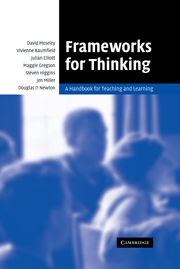Book contents
- Frontmatter
- Contents
- List of figures
- List of tables
- Notes on authors
- Foreword
- Acknowledgments
- Introduction
- 1 The nature of thinking and thinking skills
- 2 Lists, inventories, groups, taxonomies and frameworks
- 3 Frameworks dealing with instructional design
- 4 Frameworks dealing with productive thinking
- 5 Frameworks dealing with cognitive structure and/or development
- 6 Seven ‘all-embracing’ frameworks
- 7 Moving from understanding to productive thinking: implications for practice
- References
- Index
Introduction
Published online by Cambridge University Press: 22 September 2009
- Frontmatter
- Contents
- List of figures
- List of tables
- Notes on authors
- Foreword
- Acknowledgments
- Introduction
- 1 The nature of thinking and thinking skills
- 2 Lists, inventories, groups, taxonomies and frameworks
- 3 Frameworks dealing with instructional design
- 4 Frameworks dealing with productive thinking
- 5 Frameworks dealing with cognitive structure and/or development
- 6 Seven ‘all-embracing’ frameworks
- 7 Moving from understanding to productive thinking: implications for practice
- References
- Index
Summary
This handbook is about thinking. More specifically, it is about theoretical frameworks and classificatory systems developed since the Second World War to help educators understand the processes and products of thinking and learning. By setting out the ideas and beliefs of various system builders it raises questions about human nature and the nature of knowledge. However, it is far from comprehensive in its treatment of philosophical issues, since the starting point for our work was a brief from the Learning and Skills Research Centre (LSRC), based in London, to evaluate thinking skills taxonomies which may be relevant in post-16 education and training. Our main purpose is practical, so we are more interested in how frameworks can be used than in theoretical elegance.
Everyone involved in education and training needs to talk about thinking and learning. Frameworks for thinking can provide shared understandings which can help improve the quality of instructional design, course and lesson planning, teaching, learning and assessment. We therefore believe that this handbook will be useful for practitioners, students and academics as well as for policy-makers and others wanting to find out more about certain frameworks.
Here, as in the published report of our work for the LSRC (Moseley et al., 2004), we include frameworks and models as well as taxonomies, and are just as interested in school education as the post-16 sector.
- Type
- Chapter
- Information
- Frameworks for ThinkingA Handbook for Teaching and Learning, pp. 1 - 7Publisher: Cambridge University PressPrint publication year: 2005



